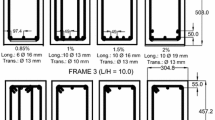Abstract
A nonlinear damage model based on the combination of deformation and hysteretic energy and its validation with experiments are presented. Also, a combination parameter is defined to consider the mutual effect of deformation and hysteretic energy for different types of components in different loading stages. Four reinforced concrete (RC) columns are simulated and analyzed using the nonlinear damage model. The results indicate that the damage evolution evaluated by the model agrees well with the experimental phenomenon. Furthermore, the seismic damage evolution of a six-story RC frame was analyzed, revealing four typical failure modes according to the interstory drift distribution of the structure; the damage values calculated using the nonlinear damage model agree well with the four typical failure modes.


















Similar content being viewed by others
References
Zhang, P.Z., Hou, S., Ou, J.P.: A beam–column joint element for analysis of reinforced concrete frame structures. Eng. Struct. 118, 125–136 (2016)
Banazadeh, M., Shokrabadi, M., Shokrabadi, M., et al.: Assessment of seismic risks in code conforming reinforced concrete frames. Eng. Struct. 98, 14–28 (2015)
Sun, B.T., Zhang, G.X.: The Wenchuan earthquake creation of a rich database of building performance. Sci. China Technol. Sci. 53, 2668–2680 (2010)
Rossetto, T., Peiris, N.: Observations of damage due to the Kashmir earthquake of October 8, 2005 and study of current seismic provisions for buildings in Pakistan. Bull. Earthq. Eng. 7, 681–699 (2009)
Ning, N., Qu, W.J., Ma, Z.G.: Design recommendations for achieving ‘strong column–weak beam’ in RC frames. Eng. Struct. 126, 343–352 (2016)
Ghannoum, W.M., Moehle, J.P., Bozorgnia, Y.: Analytical collapse study of lightly confined reinforced concrete frames subjected to Northridge earthquake ground motions. J. Earthq. Eng. 12, 1105–1119 (2008)
Colombo, A., Negro, P.: A damage index of generalised applicability. Eng. Struct. 27, 1164–1174 (2005)
Do, T., Filippou, F.: A damage model for structures with degrading response. Earthq. Eng. Struct. Dyn. 47, 311–332 (2018)
Kim, T.H., Lee, K.M., Chung, Y.S., et al.: Seismic damage assessment of reinforced concrete bridge columns. Eng. Struct. 27, 576–592 (2015)
Martins, L., Silva, V., Marques, M., et al.: Development and assessment of damage-to-loss models for moment-frame reinforced concrete buildings. Earthq. Eng. Struct. Dyn. 45, 797–817 (2016)
Rodriguez, M.E., Padilla, D.: A damage index for the seismic analysis of reinforced concrete members. J. Earthq. Eng. 13, 364–383 (2009)
Park, Y.J., Ang, A.H.S.: Mechanistic seismic damage model for reinforced concrete. J. Struct. Eng. 111, 722–739 (1985)
Mander, J.B., Cheng, C.T.: Replaceable hinge detailing for bridge columns. Int. Concr. Abstr. Portal 187, 185–204 (1999)
Lu, D.G., Wang, G.Y.: Decision-making method of optimal fortification level for aseismic structures based on damage performance. China Civil Eng. J. 7, 44–49 (2001). (in Chinese)
Niu, D.T., Ou, J.P., Du, X.L.: Random earthquake ground motion model and its parameter determination used in aseismic design. Earthq. Eng. Eng. Vib. 11, 45–54 (1991)
Brasiliano, A., Doz, G.N., Brito, J.L.V.: Damage identification in continuous beams and frame structures using the residual error method in the movement equation. Nucl. Eng. Des. 227, 1–17 (2004)
Hognestad, E.: Study of combined bending and axial load in reinforced concrete members. Ph.D. Thesis, University of Illinois, New York (1951)
Bonora, N.: A nonlinear CDM model for ductile failure. Eng. Fract. Mech. 58, 11–28 (1997)
Zhang, G.J.: Research on seismic behavior of high strength reinforced concrete frame columns in large-scale thermal power plants. [Ph.D. Thesis], Xi’an University of Architecture & Technology, Xi’an (2003). (in Chinese)
Deng, M.K.: Theory and experimental research on performance-based seismic design of high performance concrete shear wall. [Ph.D. Thesis], Xi’an University of Architecture & Technology, Xi’an (2006). (in Chinese)
Ile, N., Reynouard, J.M.: Nonlinear analysis of reinforced concrete shear wall under earthquake loading. J. Earthq. Eng. 4, 183–213 (2000)
Thanh, N.T.C., Li, B.: Ultimate displacement of reinforced concrete columns with light transverse reinforcement. J. Earthq. Eng. 17, 282–300 (2013)
Acknowledgements
The project was supported by the National Natural Science Foundation of China (Grant 51578058) and the Beijing Natural Science Foundation (Grant 8172038).
Author information
Authors and Affiliations
Corresponding author
Rights and permissions
About this article
Cite this article
Xiao, S., Xu, L. & Lu, X. Nonlinear damage model for seismic damage assessment of reinforced concrete frame members and structures. Acta Mech. Sin. 34, 949–962 (2018). https://doi.org/10.1007/s10409-018-0779-7
Received:
Revised:
Accepted:
Published:
Issue Date:
DOI: https://doi.org/10.1007/s10409-018-0779-7




